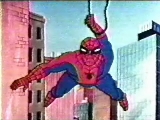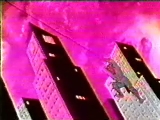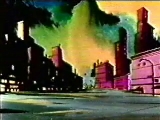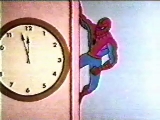

For more great information about the series, visit Wonders Unbound: Human Imagination at Extremes.
 Spider-Man
was launched in his first television series in 1967 in what would become one of
his more memorable TV portrayals. Spidey managed to last four years, three
seasons, seventy-seven episodes, and fifty-two half-hour shows before his
dismissal in 1970.
Spider-Man
was launched in his first television series in 1967 in what would become one of
his more memorable TV portrayals. Spidey managed to last four years, three
seasons, seventy-seven episodes, and fifty-two half-hour shows before his
dismissal in 1970.
At the beginning of the series's life, production was headed by Grantray-Lawrence Animation in Toronto, Ontario. Production moved to New York City, being directed by Ralph Bakshi of Krantz Films, for the second and third seasons. Once Ralph Bakshi took over, much was done to reduce production costs from superimposed lip movement to recycled shots of Spider-Man swinging over the city.
 Because of the transition, many changes were made to the series physically and technically
between the first season and the latter two seasons. One of the most memorable
changes that most people are quick to remember is the transformation of the
skies above New York City. Once blue and clear skies became dark and dreary with
multicoloured clouds giving a depressing feeling. What had once seemed like a perky place had become a dark and eerie town.
Another memorable change was the musical score. While all of the music from the
first season remained, background music became very moody from hop-and-bop dance
music with Spidey swinging along to ominous and mysterious music as Spider-Man
explored beneath the surface of the earth. Another noticeable difference was the portrayal of
Peter Parker's daily life. Before, Peter had battled his classic foes as
Spider-Man while J. Jonah Jameson was raving about the situation in the city
being the fault of Spider-Man. Later, his life was more focused on school and
social while he battled molemen from underneath the world to mysterious vine
creatures in another world as Spider-Man. A fourth change was the titling of
episodes. In season one, the adventure would begin up to a climatic point, and
then the title screen would be shown. In seasons two and three, the title screen
was shown first and then the story would begin. Season one titles were
printed in yellow text against a web above the city. In seasons two and three,
titles were printed in white text against a harbour. Also, it is easily noticeable
that the title screens stay on the screen longer in season three compared to the
first two seasons.
Because of the transition, many changes were made to the series physically and technically
between the first season and the latter two seasons. One of the most memorable
changes that most people are quick to remember is the transformation of the
skies above New York City. Once blue and clear skies became dark and dreary with
multicoloured clouds giving a depressing feeling. What had once seemed like a perky place had become a dark and eerie town.
Another memorable change was the musical score. While all of the music from the
first season remained, background music became very moody from hop-and-bop dance
music with Spidey swinging along to ominous and mysterious music as Spider-Man
explored beneath the surface of the earth. Another noticeable difference was the portrayal of
Peter Parker's daily life. Before, Peter had battled his classic foes as
Spider-Man while J. Jonah Jameson was raving about the situation in the city
being the fault of Spider-Man. Later, his life was more focused on school and
social while he battled molemen from underneath the world to mysterious vine
creatures in another world as Spider-Man. A fourth change was the titling of
episodes. In season one, the adventure would begin up to a climatic point, and
then the title screen would be shown. In seasons two and three, the title screen
was shown first and then the story would begin. Season one titles were
printed in yellow text against a web above the city. In seasons two and three,
titles were printed in white text against a harbour. Also, it is easily noticeable
that the title screens stay on the screen longer in season three compared to the
first two seasons.
 Voice acting went, for the most part, uncredited. Only the show's four
principal cast
members--Bernard Cowan, Paul Soles, Paul Kligman, and Peg Dixon--ever received
on-screen credit. To make it easier to understand, here is a table of all the known voice actors
of the show and which characters they played that I have gathered.
Voice acting went, for the most part, uncredited. Only the show's four
principal cast
members--Bernard Cowan, Paul Soles, Paul Kligman, and Peg Dixon--ever received
on-screen credit. To make it easier to understand, here is a table of all the known voice actors
of the show and which characters they played that I have gathered.
This list is a work in progress. If you have anything to contribute to it, especially names not currently listed, then please e-mail me with your information.
| Carl Banas | Scorpion/Charles Cameo |
| Len Carlson | Green Goblin/Parafino/Bolton/Jan Caldwell/Captain Ned Stacy/Vegio |
| Bernard Cowan | Dr. Magneto/Cowboy/Dr. Von Schlick/Narrator |
| Peg Dixon | Betty Brant/Mrs. Conner/Adelaide/Aunt May Parker/Marie/Miss Trubble/Diana/Mrs. Van Meer/Emily Thorndike/Countess Belinski/Polly/Mary Jane |
| Gillie Fenwick | Dr. Smartyr/Lizard Man/Dr. Curtis Conner/Plotter/Pardo |
| Max Ferguson | Phantom/Executioner of Paris |
| Tom Harvey | Electro/Director/Dr. Stilwell/Sandman/Dr. Octopus/Master Technician/Mugs Riley/Master Vine/Clive/Baron Von Rantenraven/Dr. Atlantian/Radiation Specialist |
| Paul Kligman | J. Jonah Jameson/Jake/Hippie Poet/Lee Patterson/Otto |
| Jack Mather | Jesse James |
| Ed McNamara | Rhino/Blackbeard/Vulcan |
| Henry Ramer | Henry Smythe/Grandini the Mystic/Dr. Noah Boddy/Mr. Flintridge/Lee Patterson |
| Claude Ray | Charles Cameo |
| Billie Mae Richards | Paper Boy/ Billy Conner |
| Alfie Scopp | Jewelry Store Clerk |
| Paul Soles | Peter Parker/Spider-Man/Fantastic Fakir/Ox/Vulture |
| Chris Wiggins | Mysterio/Harley Clivendon/Blackwell/Boomer/Infinata |
 Season one consisted of thirty-eight episodes in twenty half-hour shows. All
shows consisted of two fifteen -minute episodes except episodes three and eight
which were complete half-hour episodes. All of season two's nineteen episodes
were half-hour adventures. Season three was a mix of fifteen and thirty minute
episodes. Of the thirteen shows, seven of them had two fifteen-minute episodes,
and six of them had half-hour adventures. The first season started with the
series premiere September 9, 1967 on ABC. The second
season started September 14, 1968 after the last first-run shows of season one
had aired a few days shy of eight months. For the third season, after being
delayed in getting on the air, Spider-Man went
syndicated. The third season began March
22, 1970 after the final show of the second season had aired over fourteen
months ago. The final first run show aired May 14, 1970, and after fifty-two
shows, production ended.
Season one consisted of thirty-eight episodes in twenty half-hour shows. All
shows consisted of two fifteen -minute episodes except episodes three and eight
which were complete half-hour episodes. All of season two's nineteen episodes
were half-hour adventures. Season three was a mix of fifteen and thirty minute
episodes. Of the thirteen shows, seven of them had two fifteen-minute episodes,
and six of them had half-hour adventures. The first season started with the
series premiere September 9, 1967 on ABC. The second
season started September 14, 1968 after the last first-run shows of season one
had aired a few days shy of eight months. For the third season, after being
delayed in getting on the air, Spider-Man went
syndicated. The third season began March
22, 1970 after the final show of the second season had aired over fourteen
months ago. The final first run show aired May 14, 1970, and after fifty-two
shows, production ended.
 Even though the show ended, it still would find its time on TV somewhere.
Because the first season was produced in Canada, repeats have been seen for many
years now. The show was more recently seen in repeats from 1994 to 1998 on YTV,
and since 2001, it has been off and on Teletoon. Teletoon only tends to air
the first twenty-six episodes because their license with the CRTC requires them
to have at 60% Canadian content airing between 6:00 P.M. and midnight, but
episodes twenty-seven through fifty-two do get aired every so often; however,
Teletoon does not repeat episode nine due to derogatory remarks within that
show, probably because the instance where Jameson says there should be no women in the
world or because of when Spidey refers to Clivendon's Aborigine assistant as a
"nice doggy." In addition to repeats, individual episodes were released on VHS throughout the
years, yet the entire series had yet to be released entirely altogether.
After many years of wanting, our hopes were answered. Buena Vista did a
restoration process of the series for digital video. On June
28, 2004, "Spider-Man the '67 Collection" was released with all fifty-two
episodes on a six DVD set. While the DVD set was advertised having all the
episodes fully restored, some episodes were not completely restored in either
video or audio form or, in some cases, both. On September 1, 2005, the
Family channel in Canada began airing repeats of the show with the restored
video and audio. On September 10, 2005, CBC
Radio Canada began airing the French dub of the show with the restored video as
well. This would also mark the first time in over
fifteen years that the French dub aired since it's original run.
Even though the show ended, it still would find its time on TV somewhere.
Because the first season was produced in Canada, repeats have been seen for many
years now. The show was more recently seen in repeats from 1994 to 1998 on YTV,
and since 2001, it has been off and on Teletoon. Teletoon only tends to air
the first twenty-six episodes because their license with the CRTC requires them
to have at 60% Canadian content airing between 6:00 P.M. and midnight, but
episodes twenty-seven through fifty-two do get aired every so often; however,
Teletoon does not repeat episode nine due to derogatory remarks within that
show, probably because the instance where Jameson says there should be no women in the
world or because of when Spidey refers to Clivendon's Aborigine assistant as a
"nice doggy." In addition to repeats, individual episodes were released on VHS throughout the
years, yet the entire series had yet to be released entirely altogether.
After many years of wanting, our hopes were answered. Buena Vista did a
restoration process of the series for digital video. On June
28, 2004, "Spider-Man the '67 Collection" was released with all fifty-two
episodes on a six DVD set. While the DVD set was advertised having all the
episodes fully restored, some episodes were not completely restored in either
video or audio form or, in some cases, both. On September 1, 2005, the
Family channel in Canada began airing repeats of the show with the restored
video and audio. On September 10, 2005, CBC
Radio Canada began airing the French dub of the show with the restored video as
well. This would also mark the first time in over
fifteen years that the French dub aired since it's original run.
 And while many turn off this show because of various reasons ranging from bad
animation, recycled shots, twisted plots, and (in some opinions) lifeless voices; Spider-Man has
managed to find his place in some people with this series. While it may have had
a low budget, it was something we remember from Saturday mornings on TV when we
were young. That fact that the reels of the show were not simply destroyed after
the series was done but managed to find a place somewhere airing on some station
shows that there was liking and people did like this series. The '60s series of
Spider-Man is truly a piece of history that will never be forgotten.
And while many turn off this show because of various reasons ranging from bad
animation, recycled shots, twisted plots, and (in some opinions) lifeless voices; Spider-Man has
managed to find his place in some people with this series. While it may have had
a low budget, it was something we remember from Saturday mornings on TV when we
were young. That fact that the reels of the show were not simply destroyed after
the series was done but managed to find a place somewhere airing on some station
shows that there was liking and people did like this series. The '60s series of
Spider-Man is truly a piece of history that will never be forgotten.